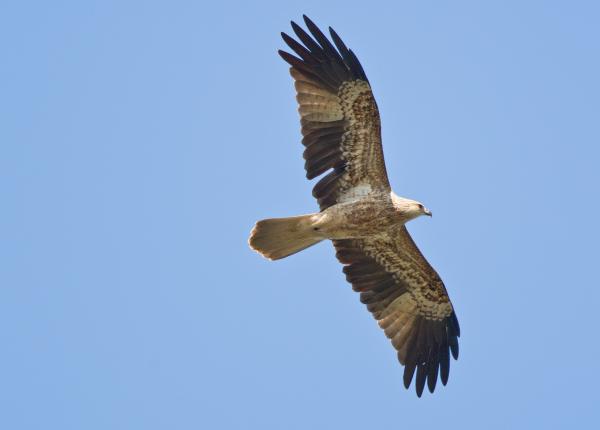Did You Know?
- There are only two species in the genus Haliastur, and the Whistling Kite is one of them.
- The Whistling Kite is also sometimes called Carrion Hawk or Whistling Eagle
- Its scientific name "sphenurus" means wedge tail, which describes this species' tail perfectly.
How The Peregrine Fund is Helping
Though The Peregrine Fund does not work directly with Whistling Kites, our efforts in scientific research, habitat conservation, education, and community development help conserve birds of prey around the world. We also supply literature to researchers from our avian research library, which helps scientists around the world gather and share important information on raptor conservation. Our work with the Global Raptor Information Network gives raptor researchers tools to more efficiently conduct their own studies while contributing to a global program. It also provides citizen scientists a way to participate in raptor science and conservation.
Where They Live
The Whistling Kite is found throughout much of Australasia, including in Australia, New Caledonia, and eastern and southern New Guinea. It inhabits a wide variety of habitats and can be seen soaring or hunting around swamps, lakes, rivers, estuaries, coastlines, savanna woodland, and other open country. It has even been seen near air strips and other open, human altered landscapes.
What They Do
True to its name, the Whistling Kite is quite a vocal species. Whistles, chatters, and short, sharp notes are all in its repertoire. This beautiful kite spends a lot of time circling slowly above open habitats. Though it is often solitary, it can be seen flying together with other Whistling Kites or sometimes with Black Kites. Sometimes flocks of more than 30 Whistling Kites gather together in areas where there are concentrated food sources.
Why They Need our Help
This species is categorized as Least Concern. This means that conservationists believe this kite's population is stable and isn't in any danger in the foreseeable future. Indeed, this kite is quite common throughout much of its range and is benefiting from human activity. However, this doesn't mean this bird isn't facing some threats. In the past, DDT caused eggshells to thin, and today some wetland areas are being drained, meaning their habitat and food supply are becoming scarcer in some parts of their range.
What They Eat
The Whistling Kite has a long list of items on its menu. It will feed on fish, both live and dead. It will also take mammals, such as rabbits, and birds including geese (both hatchlings and adults) and swallows. It will also prey upon reptiles, crustaceans, and insects. It is also a carrion feeder and will dine on road-kill both large and small.
It employs a few different hunting techniques to capture its prey. It might sit patiently in a tree, often besides water or drying pools, and then drop leisurely onto its prey. It sometimes grabs prey from the surface of water bodies, or it might catch insects on the wing. It patrols along roads and near grass fires to search for road kill or small animals fleeing the flames and smoke.
But that is not all! It has been observed stealing food from other raptors, and harassing waterbirds until they regurgitate their last meal. It cleverly hangs around fishermen to scavenge from the guts and other bits they discard.
Nests, Eggs, and Young
This stunning kite prefers to nest in riparian habitats. The build bowl-shaped nest made of sticks, that are lined with green leaves. They build their nests in the fork of a live or dead tree.
The female will lay between one to four eggs, though it is most common for her to lay 2 eggs per clutch. The eggs need to be incubated for about 35 days. After the nestlings hatch, they are covered in fluffy, cream-colored down. But, they will develop quickly and in less than 2 months they will be ready fo fly from the nest for the first time. After they leave the nest, they will remain with their parents for up to two months perfecting their hunting techniques and learning how to avoid dangers.
Whistling Kite and the World Center for Birds of Prey
The World Center for Birds of Prey offers fun ways to learn about birds of prey. The visitor center has interactive displays, tours, interesting videos and a children's room with activities from coloring sheets to quizzes to costumes and a touch table for the curious mind. We also have several different birds of prey on display year-round. Knowledgeable staff and volunteers are on hand to answer any questions you may have about Whistling Kites or any other birds of prey.
References:
Debus, S., T. S. David, and G. M. Kirwan (2021). Whistling Kite (Haliastur sphenurus), version 1.1. In Birds of the World (S. M. Billerman, Editor). Cornell Lab of Ornithology, Ithaca, NY, USA. https://doi.org/10.2173/bow.whikit1.01.1
Global Raptor Information Network. 2022. Species account: Whistling Kite Haliastur sphenurus. Downloaded from http://www.globalraptors.org on 30 Mar. 2022
Slater, Peter; Pat Slater; Raoul Slater (1986). The Slater Field Guide to Australian Birds. Sydney: Reed New Holland.










